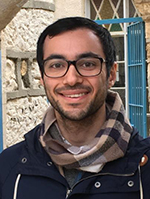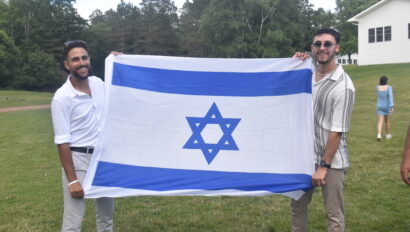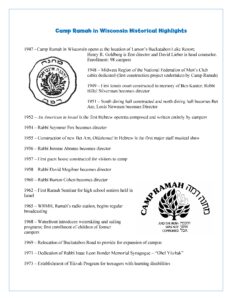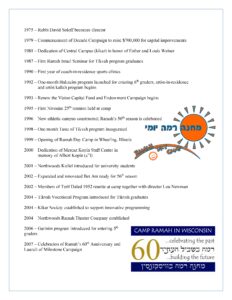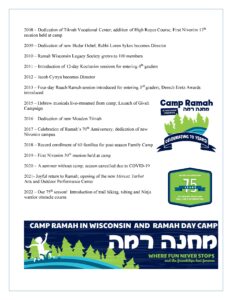Please enjoy a d’var Torah this week from Rosh Machon 2018 Benjy Forester. Originally from Deerfield, Illinois, Benjy is returning to Ramah Wisconsin for his 12th summer at camp. After graduating from Washington University in St. Louis, Benjy spent a year working with JDC’s Jewish Service Corps in Budapest, Hungary. Benjy returned to the US this year to study in the Hadar Institute’s full-time yeshiva fellowship, and Benjy will be staying in New York City next year to begin Rabbinical School at the Jewish Theological Seminary.
In God’s Image: Reflections on Parashat Kedoshim
by Benjy Forester
I’m sure many of you can relate to the feeling of helplessly trying to explain the experience of Camp Ramah to someone who has never attended before. You try to explain the thrill of kikar dancing, the bonds of lifelong friendship, your devotion to learning a Broadway musical in Hebrew, or any of the other daily sensations that occur at Ramah. Beyond struggling to translate words whose English meanings we have long forgotten, words fail to capture the transformative power of Ramah.
While words fail to describe Ramah itself, a word DOES exist to describe the helpless inability to explain the camp experience. Frustrated by the English language’s inability to capture a variety of unique feelings and experiences, a man named John Koenig created neologisms to fill those gaps and describe the indescribable. He called the project The Dictionary of Obscure Sorrows. Back to our example at hand, I’m sure we can all relate to the classic feeling of “exulansis,” defined as “the tendency to give up trying to talk about an experience because people are unable to relate to it.”
One of my favorite words that Koenig coined is ‘sonder,’ which he beautifully explains as “the realization that each random passerby is living a life as vivid and complex as your own—populated with their own ambitions, friends, routines, worries and inherited craziness—an epic story that continues invisibly around you.” We get so focused on the epic story of our own lives that we forget that each person around us lives a life filled with equally exciting narratives.
In reading through Parashat Kedoshim, I couldn’t help but think of sonder when I encountered the famous appeal, “וְאָֽהַבְתָּ֥ לְרֵעֲךָ֖ כָּמ֑וֹךָ,” that we must love our fellow as ourselves (Vayikra 19:18). I personally feel encouraged by this reminder to escape the confines of my own head and my own story in which I am the protagonist, and remember to dispense the same care and kindness that I hope to receive.
Inspired by this model of benevolence and support, Rabbi Akiva implores, “זה כלל גדול בתורה,” or “This is the greatest principle in the whole Torah!” (Sifra Kedoshim 4:12). Our campers mark Rabbi Akiva’s emphatic declaration by jumping, dancing, and singing to the Yeshiva Boys Choir’s musical rendition of these words during shirah (song) sessions in the chadar ochel. Indeed, the legacy of Rabbi Akiva’s words endures in our collective memory, with fewer biblical phrases known more ubiquitously.
Right after this claim of Rabbi Akiva, the Sifra records Ben Azzai’s rebuttal, instead nominating “זה ספר תולדות אדם” or “This is the record of Adam’s line” (Breishit 5:1) as an even greater paradigmatic principle. On a surface level, Ben Azzai counters with a mundane and perplexing quote that in no way rivals the depth of Rabbi Akiva’s proposal. However, the verse Ben Azzai quotes continues, “This is the record of Adam’s line. — When God created man, God made him in the image of God.” Ben Azzai is most likely not emphasizing the actual genealogical record that follows; rather, he highlights that Adam’s progeny, meaning ALL of humanity, is made in God’s image. Indeed, Ramban and other commentators note that the word ספר stands out from other introductions to genealogies, and suggest that the text is saying that the ספר (book/record) of Adam’s progeny is in fact the Torah itself, a book of people made in God’s image!
Perhaps Ben Azzai does not reject Rabbi Akiva’s suggestion, but instead teaches a crucial lesson. The ideal of loving others is useful in organizing a society, but its ethos and force derives from the realization that we inhabit a world filled with other people created by God in God’s image. With this understanding, the protagonist of the story of life shifts from me to God, under whom all of humanity is equally special. God gazes at the world through the lens of sonder, watching all people’s infinitely complex lives unfold simultaneously. Our challenge of imitatio dei is to see everyone else as worthy and valuable, just as we see ourselves. Only with this orientation to others can we truly, wholly, and sustainably manage to fulfill Rabbi Akiva’s charge to love others as ourselves. In Breishit Rabbah, Rabbi Tanchuma makes this point clear, saying that people will not scorn others (and therefore transgress the instruction to treat others as ourselves) if they understand that they are scorning someone made in God’s image, and therefore scorning God Himself (Breishit Rabbah 24:7).
At Ramah, we teach our campers the values and skills of building holy community and creating lifelong friendships. Along the way, campers build these crucial interpersonal skills in the cabin, on the sports courts, in musicals, in song and dance, and beyond. We hope that when people visit our camp or meet our campers in their communities outside of camp, they see the respect and kindness with which they treat their peers. While our madrichim (counselors)certainly build expectations that campers treat others as they would want to be treated, we only succeed in building a community of sustained respect and kindness by making clear that each and every camper is a unique, valuable, and a crucial member of our community. By building a culture in which campers are valued as being made in God’s image and feel at home and appreciated for their whole, unique selves, our camp transforms into a true kehillah kedosha, just as Parashat Kedoshim envisions.
